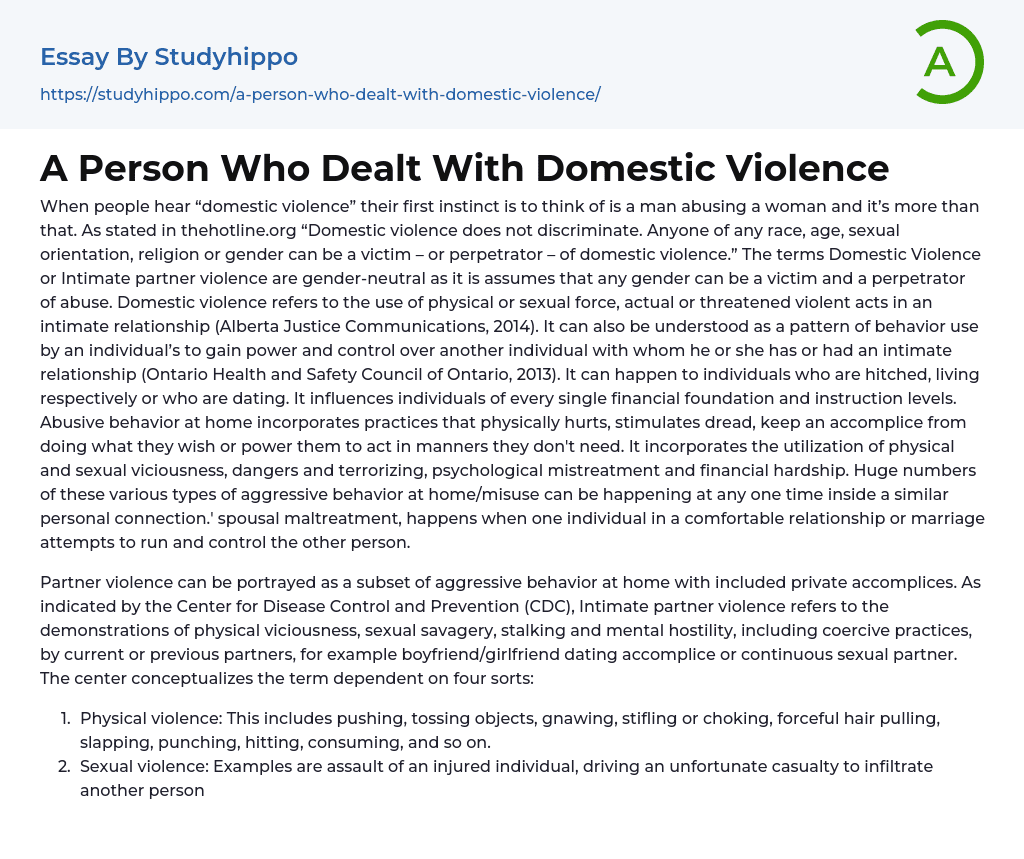Contrary to common belief, domestic violence is not limited to men abusing women. It can affect individuals of any race, age, sexual orientation, religion, or gender (thehotline.org). Both men and women can be victims or perpetrators of domestic violence. The terms "Domestic Violence" or "Intimate partner violence" are inclusive because they acknowledge that anyone can experience or engage in abusive behavior. Domestic violence involves the use of physical or sexual force within an intimate relationship, whether it is actual or threatened (Alberta Justice Communications, 2014). Furthermore, it can be seen as a recurring pattern of behavior used by one person to exert power and control over another individual with whom they have been in an intimate relationship (Ontario Health and Safety Council of Ontario, 2013).
Abuse can happen in different relationship settings, like marriage, cohabitation, or dating. It is not restricted to any particular socioeconomic or educational back
...ground. Domestic violence covers acts that cause physical harm, instill fear, limit a partner's freedom, or coerce them into unwanted behaviors. These acts include physical and sexual violence, threats and intimidation, psychological abuse, and causing financial difficulties.
Intimate relationships often involve various forms of aggressive behavior, including spousal maltreatment. This occurs when one person in a close relationship or marriage seeks to control and dominate the other. Partner violence is a specific type of domestic violence that occurs between intimate partners.
According to the Center for Disease Control and Prevention (CDC), intimate partner violence encompasses physical violence, sexual violence, stalking, and psychological aggression using coercive tactics. The CDC categorizes these types as follows:
1. Physical violence: Examples include pushing, throwing objects, biting, choking, aggressive hair pulling, slapping, punching, hitting, and burning.
2. Sexua
violence: This includes acts such as rape; forcing a victim to penetrate another person; or non-physically coercing unwanted penetration or unwanted sexual contact.
3. Stalking: Repeated and unwanted attention or contact that causes fear or concerns about one's safety or the well-being of another person.
4. Psychological Aggression: The use of verbal and non-verbal communication with the intention to emotionally or mentally harm someone else.
The World Health Organization (2010) states that intimate partner violence can occur in various settings and among all economic, religious, and social groups worldwide. However, it is commonly associated with gender-related implications where men are depicted as perpetrators and women as victimsAccording to the WHO (2010), women may use violence against men in self-defense, while emphasizing that it is usually male intimate partners or ex-partners who commit acts of violence against women.
According to feminist ideologies, it is suggested that men are more likely to experience violent acts from strangers or colleagues rather than someone close to them. This diverts the perception of intimate partner abuse as violent behavior and instead portrays it as a gender-oriented phenomenon that reinforces the patriarchal structure in society.
Consequently, Domestic Violence/Intimate Partner Violence (IPV) has become a prevalent issue in the United States. It is crucial for women who have experienced abuse, both currently and in the past, to receive effective treatment. Doing so is important for their individual growth and developing a better understanding of their relationships with others.
Additionally, group treatment methods can help restore women back into society and provide them with various benefits.




